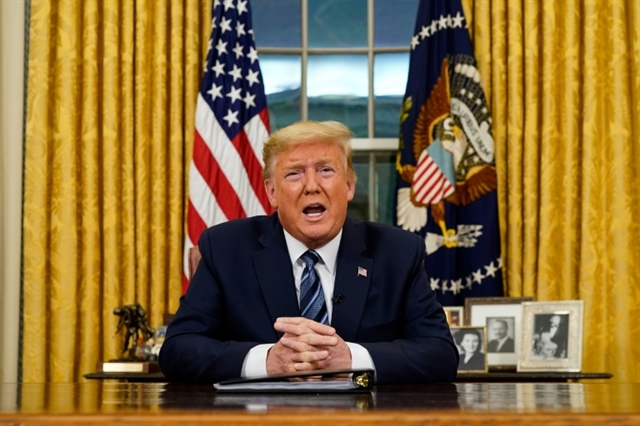 World
World

US President Trump imposed a travel ban on Europe for 30 days, and stated trade would be halted but later backtracked.

|
| US President Donald Trump addresses the Nation from the Oval Office about the widening novel coronavirus crisis on March 11, 2020. — AFP/VNA Photo |
WASHINGTON — US President Donald Trump announced a 30-day ban on travellers from mainland Europe on Wednesday (local time) as the continent reeled from the rapid spread of a coronavirus pandemic that has emptied streets, shuttered shops and disrupted travel for millions.
The edict came amid signs of a widening European crisis, as Italy clocked more than 2,300 new cases in 24 hours and infections in Spain jumped by a quarter to more than 2,100.
Ireland, Albania, Belgium, Sweden and Bulgaria registered their first deaths on Wednesday, bringing Europe's total to 930, from more than 22,000 infections.
"This is the most aggressive and comprehensive effort to confront a foreign virus in modern history," Trump said in a primetime television address from the Oval Office – his latest attempt to counter criticism of his response so far.
The president said the ban would come into effect from "midnight Friday" but would not affect travellers from Britain, which recently left the European Union, to Trump's great approval.
Trump briefly caused alarm as he announced that the "tremendous amount of trade and cargo" from Europe would also be banned, forcing officials to clarify that the measures would apply only to humans, not goods or cargo.
The number of coronavirus disease cases across the globe has risen to more than 124,000 with 4,500 deaths, after a jump in fatalities particularly in Iran and Italy, according to an AFP tally.
The World Health Organisation designated the outbreak as a pandemic on Wednesday, warning that the spread and severity of the illness was due to "alarming levels of inaction."
Trump said European nations had seen more cases than the US because governments had failed to stop travel from China, where the COVID-19 epidemic began, while the US had enacted an early ban.
In reality, experts believe the American figures are artificially depressed by a catastrophic delay in rolling out testing in the initial weeks of the outbreak.
The United States is orders of magnitude behind South Korea in the number of tests it has carried out, despite both countries registering their first case on the same day.
Johns Hopkins University's coronavirus tracker put the number of known US cases at around 1,300, with 36 dead.
The US got its biggest sign yet of the urgency of the crisis when the New York city government formed a containment zone around a suburb at the centre of an outbreak.
Wall Street stocks suffered another brutal rout on Wednesday, pushing the Dow into a "bear market," or 20 per cent from its peak, after the latest series of event cancellations and company warnings rattled investors.
The majority of cases have been in China, where the outbreak emerged in December, but as the number of new infections has steadied, hotspots have emerged elsewhere – namely Italy, Iran and Spain.
Meanwhile, millions of people in Italy are grappling with a nationwide clampdown, with Prime Minister Giuseppe Conte announcing Italy would shut all stores except for pharmacies and food shops to curb the disease.
Factories and other big businesses can remain open as long as they adopt "appropriate security measures to prevent contagion," Conte said.
His government vowed to spend up to 25 billion euros ($28 billion) to help contain fallout from the pandemic, including cash for hard-hit hotels and restaurants. — AFP